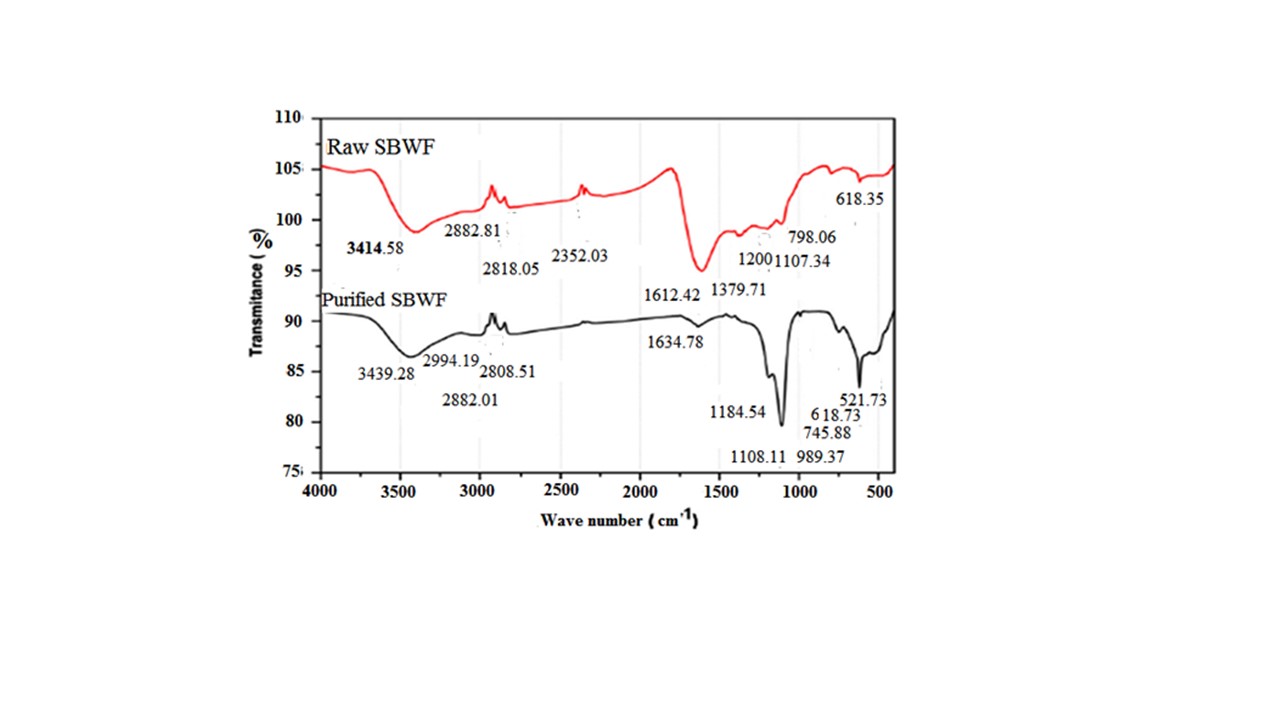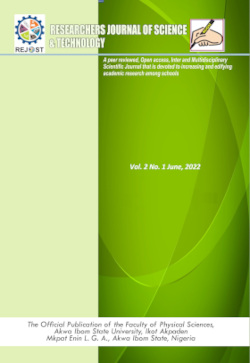Modification of Shea Butter Wood Fiber for Fiber-Polymer Composites in Automotive Interior Cabinets
Keywords:
Shear butter wood fiber, NaOH pre-treated, Compositional constituent, cellulose, lignin, hemicellulose, FTIR, SEMAbstract
The limitations of renewable material obtain from agro-based in the manufacturing sectors indicates much prospect to substitute synthetic fibers and non-metal compounds which are the traditional materials employ at esteem years old. The request of novel organic fiber, that are price friendly, minimal-mass-volume ratio and commonly available, that is reason shea butter wood flour (SBWF) employs in this work and competes with existing fibers for alternative innovative material to solve mankind issues. This research involved determination for the composition of crude and pre-treated SBWF. The SBWF was crushed and powered. The SBWF was sieved to a specific size. The SBWF was processed under controlled parameters: concentration of NaOH from 5, 10, 15 %w/v and immersed time 2, 4, 6 hr. Before modification, the crude compositional constituent of the SBWF was obtained based on cellulose (CLC), lignin (LGC) and hemicelluloses (HMC). Then, the SBWF was pretreated at the variant concentration ant soaking period. The chemically compositions of the chemically modified SBWF was obtained and tabulated. The Fourier transform infra red (FTIR) and scanning electron microscopy (SEM) to examine the active radicals and morphology were imposed on the crude and pre-treated SBWF at ultimate condition. From the displayed outcome, the raw compositional constituents were 48.5 %, 13.27 % and 24.76 % for CLC, LGC and HMC, respectively. On the other note, the pre-treated SBWF showed a significant improvement in CLC, LGC and HMC at the variation of concentration and time. The FTIR and SEM examination showed displacement in the position of apex for the spectrum and more roughness of the micrograph due to the aid of chemical influence of the SBWF, respectively. Finally. at optimum state of 10 % w/v NaOH and 4hr immersion period, the CLC, LGC and HMC were 75.15 %, 10.28 and 4.97 %, respectively. The result exhibited by CLC from the novel SBWF is a promising engineering component for automobile parts.
References
Abdul Khalil, H. P. S., Alwani, M. S., & Omar, A. M. (2006). Chemical composition, anatomy, lignin distribution, and cell wall structure of Malaysian plant waste fibers. BioResources, 1 (2): 220-232.
Agu, C. V., Njoku, O. U., Chilaka, F. C., Agbiogwu, D., IIoabuchi, K. V., and Ukazu, B. (2014). Physiochemical properties of lignocellulosic biofibers from south eastern Nigeria: their suitability for biocomposite technology. African Journal of Biotechnology, 13 (20): 2050-2057.
Ahmadi, F., Zamiri M. J., Khorvash M., Ziaee E., and Polikarpov I. (2016). Pre-treatment of sugarcane bagasse with a combination of sodium hydroxide and lime for improving the ruminal degradability: Optimization of process parameters using response surface methodology. Journal of Applied Animal Research. 44(1):287–96.
Atuanya, C. U., Government, R. M., Nwobi-Okoye, C. C. & Onukwuli, O. D. (2014). Predicting the mechanical properties of date palm wood fibre-recycled low density polyethylene composite using artificial neural network. International Journal of Mechanical and Materials Engineering, 1(7), 1-20.
Bogoeva-Gaceva, G., Avella, M., Malinconico, M., Buzarovska, A., Grozdanov, A., Gentile, G. & Erric
Barlianti, V., Dahnum, D., Hendarsyah, H. & Abimanyu, H. (2015). Effect of alkaline pretreatment on properties of lignocellulosic oil palm waste. Procedia Chemistry. 16: 195–201.
Brinchi, L., Cotana, F., Fortunati, E., & Kenny, J. M. (2013). Production of nanocrystalline cellulose from lignocellulosic biomass: technology and applications. Carbo-hydrate Polymers, 94 (1): 154-169.
Chen, Y., Tshabalala, M. A., Gao J, Stark, N. M., Fan, Y., & Ibach, R. E. (2014). Thermal behavior of extracted and delignified pine wood flour.
Thermochimica Acta, 40–4. http://dx.doi.org/10.1016/j.tca.2014.06.012
Dungani, R., Karina, M., Subyakto, Sulaeman, A., Hermawan, D. & Hadiyane, A. (2016). Agricultural waste fibers towards sustainability and advanced utilization: A review. Asian Journal of Plant Sciences. 15(1–2):42–55. http://dx.doi.org/10.3923-/ajps.2016.42.55.
Government, R. M., Okeke, E.T., Odera, R. S., Ani A. K., Thaddeus J.& Ikechukwu N.B. (2020a). Significance of alkaline treatment in the composition of mango seed shell fiber for polymer composite application. Indian Journal of Science and Technology. 13(21):2168-2174. https://doi.org/10.1-7485/IJST/v13121.81.
Government, R. M & Onukwuli, O. D. (2025). Optimization of alkali modified breadfruit peel flour-LDPE composite for car mirror casings. Materials Testing; 67(3): 471–481.
Government, R. M., Thaddeus, J., Thompson E. O., Ani, A.K. and Apake D. D. (2020b). Optimizing the cellulose content of shea butter bark wood fibre through alkali pretreatment for composite application. Indian Journal of Science & Technology. 13(04): 384 - 399. DOI: 10.17485/ijst/-2020/v013104/147288.
Government, R., Olowokere, J., Odineze, C., Anidobu, C., Yerima, E. and Nnaemeka, B. (2019). Influence of soaking time and sodium hydroxide concentration on the chemical composition of treated mango seed shell flour for composite application. Journal of Applied Sciences and Environmental Management, 23(1): 21 - 28.
Government, R. M., Onukwuli, O. D., & Ani, A. K. (2017). Chemically treated avocado wood flour - LLDPE composite, USA. Universal Journal of Material Science, 27- 40.
Government, R. M., Onukwuli, O. D., & Jibatswen, T. Y. (2018). Optimization of chemical treatment of avocado pear wood filler on the properties of LDPE composites, International Conference Processing: Fac. Engineering, UNIZIK. 499-509.13th-14th August.
Hattallia, S., Benaboura, A., Ham-Pichavant, F., Nourmamode, A. & Castellan, A. (2002). Adding value to alfa grass (Stipa tenacissima L.), soda lignin as phenolic resins. 1. Lignin characterization. Polymer Degradation Stability, 75: 259–264.
Hemmasi, A. H., Samariha, A., Tabei, A., Nemati, M, & Khakifirooz, A. (2001). A study of morphological and chemical composition of fibers from Iranian sugarcane bagasse. American-Eurasian Journal of Agricultural and Environmental Science, 11 (4): 478-481.
Herrera-Franco, P. J. & Valadez-Gonzalez, A. (2005). A study of the mechanical properties of short natural-fiber reinforced composites. Composites Part B: Engineering, 36: 597-608.
Hoareau, W., Trindada, W.G., Siegmund, B., Castellan, A. & Frollini, E. (2004). Sugar-cane bagasse and curaua lignins oxidatized by chlorine dioxide and reacted with furfuryl alcohol: characterization and stability. Polymer Degradeable Stability, 86: 567–576.
Ikramullah, R., S., Thalib, S. & Huzni, S. (2019). Hemicellulose and lignin removal on typha fiber by alkali treatment. IOP Conference Series: Materials Science and Engineering, 352(1): 1-6
Jawaid, M. & Abdul-Khalil, H. P. S. (2011). “Effect of layering pattern on the dynamic mechanical properties and thermal degradation of oil palm-jute fibers reinforced epoxy hybrid composite,” BioResources, 6: 2309-2322.
Johar, N., Ahmad, I. & Dufresne, A. (2012). Extraction, preparation and charac-terization of cellulose fibres and nanocrystals from rice husk. Industrial crops and Products, 37 (1): 93-99.
Lazim, Y., Salit, S. M., Zainudin ES, Mustapha M, & Jawaid M. (2014). Effect of alkali treatment on the physical, mechanical, and morphological properties of waste betel nut (Areca catechu) husk fibre. BioResources, 9(4):7721–36.
Mahyati, P., A. R, Djide, M. N., Taba, D. P., Rauf P., A, & Nasir D. M, (2013). Biodegradation of lignin from corn cob by using a mixture of phanerochaete chrysosporium, lentinus edodes and pleurotus ostreatus. International Journal of Scientific & Technology. 2(11): 1-4.
Marwan, M. & Nasim, U. (2016). Experimental analysis of compressed earth block (CEB) with banana fibers resisting flexural and compression forces. Case Studies in Construction Materials, 5; 53-63.
Muryanto, T. E., Abimayu, H., Cahyono, A., Cahyono, E. T. & Sudiyani, Y. (2015). Alkaline delignification of oil palm empty fruit bunch using black liquor from pretreatment. Procedia chemistry. 16:99–105.
Mwaikambo, L. Y. & Ansell, M. (2002). “Chemical modification of hemp, sisal, jute and kapok fibers by alkalization,” Journal of Applied Polymer science 84: 2222-2234. DOI:10.1002/app.10460.
Nachtigall, S. M. B., Cerveria, G. S., & Rosa, S. M. L. (2007). New polymeric-coupling agent for polypropylene/wood flour composites. Polymer Testing., 26: 619-628.
Netral, B., Sabu, T., Chapal, K. D., Rameshwar, A. (2012). Analysis of morphology and mechanical behaviors of bamboo flour reinforced polypropylene composites. Nepal Journal of Science Technology, 13(1): 95-100.
Obasi, H. C. (2015) Peanut Husk Filled Polyethylene Composites: Effects of Filler Content and Compatibilizer on Properties. Journal of Polymers. p. 1–9.
Okeke, E. T; Government, R. M.; Apake, D. D. & Ani, A. K. (2023). Effects of sodium hydroxide on the compositions of shea butter bark wood fiber for polymeric composite production in structural application. Journal of Applied Science, Environment and Management, 27(7): 1423-1429.
Oushabi, A., Sair, S., Oudrhiri Hassani, F., Abboud, Y., Tanane, O., & El Bouari, A. (2017). The effect of alkali treatment on mechanical, morphological and thermal properties of date palm fibers (DPFs): Study of the interface of DPF–Polyurethane composite. South African Journal of Chemical Engineering, 23:116–23. http://dx.doi.org/10.1016/j.sajce.-2017.04.005.
Palamae, S., Dechatiwongse, P., Choorit, W., Chisti, Y., & Prasertsan, P. (2017). Cellulose and hemicellulose recovery from oil palm empty fruit bunch (EFB) fibers and production of sugars from the fibers. Carbohydrate Polymers, Vol. 155, Elsevier Ltd.; 491-497. http://dx.doi.org/10.1016-/j.carbpol.2016.09.004.
Ray, D., Sarkar, B. K., Rana, A. K., & Bose, N. R. (2001). Effect of alkali treated jute fibres on composite properties. Bulletin of Materials Science, 24 (2): 129-135.
Reddy, K. O., Reddy, K. R. N., Zhang, J., Zhang, J., & Varada, R. A. (2013). Effect of alkali treatment on the properties of century fiber. Journal of Natural Fibers. 10(3): 282–96.
Rowell, R. M. (1998). Property Enhanced natural fiber composite material based on chemical modification, in science and technology of polymers and advanced materials, Prasad P.N., Mark J.E., Kendil S.H. & Kafafi Z.H Eds., page 717-732, Plenum Press, New York.
Rowell, R. M., Han, J. S., & Rowell J. S. (2000). Characterization and factors effecting fiber properties in natural polymers and agro fibers-based composites. Natural polymers and bio-based composites, 115–135.
Sari, N. H., Wardana, I. N. G., Irawan, Y. S., Siswanto, E. (2017). The effect of sodium hydroxide on chemical and mechanical properties of corn husk fiber. Oriental Journal of Chemistry, 33(6):3037–42.
Setswalo, K., Namoshe M., Kutua, S., Oladijo O. P. & Samson, B. (2017). Effect of thermal and alkali treatment on pterocarpus angolensis (mukwa) wood flour. Procedia Manufacturing, 7:205–10.
Shuhaida, H. & Soh, K. G. (2016) Effect of sodium hydroxide pretreatment on rice straw composition. Industrial Journal of Science Technology, 9(21): 1-9.
Srinivas, K., A. Lakshumu N., & RajuBahubalendruni, M.V.A. (2017). "A Review on chemical and mechanical properties of natural fiber reinforced polymer composites,” International Journal of Performability Engineering, 13.2: 189
Suryanto, H., Marsyahyo, E., Irawan, Y. S. & Soenoko, R. (2013). Effect of alkali treatment on crystalline structure of cellulose fiber from mendong (Fimbristylis globulosa) straw. Key Engineering Materials, 2013; 594–595
Taj, S., Munawar, M. A., & Khan, S. U. (2007). Review: Natural Fibre Reinforced Polymer Composites and Processing. Pakistan Academy of Science, 44 (2): 129 – 144.
Valadez-Gonzalez, A., Cervantes-Uc, J. M., Olayo, R. and Herrera-Franco, P. J. (1999). Effect of fiber surface treatment on the fiber-matrix bond strength of natural fiber reinforced composites, Composites Part B: Engineering, 30: 309-320.
Wambua, P., J. Ivens, & Verpoest. I. (2003). Natural fibers: Can they replace glass in fiber reinforced plastics? Composites Science and Technology, 63: 1259–1264.
Wang, Z., Li, J., Barford, J. P., Hellgradt, K. & Mckay, G. (2016). A comparison of chemical treatment methods for the preparation of rice husk cellulosic fibers. International Journal of Environmental & Agriculture Research, 2(1): 2454–1850. http://www.ijoear.com/Paper-January-2016/IJOEAR-JAN-2016-11.
Weyenberg, I. V., Truong, T. C., Vangrimde, B., Verpoest, I. (2006). Improving the properties of UD flax fiber reinforced composites by applying an alkaline fiber treatment. Composites Part A: Applied Science Manufacturing, 37 (9): 1368-1376.
William, J. & Patrick, C. (2017). Improving the properties of banana fiber reinforced polymeric composites by treating the fibers‖ 3rd international conference on natural fibers: Advanced Materials for a Greener World, ICNF 2017, 21-23 June 2017, Braga, Portugal.
Wong, K. J., Zahi, S., Low, K. O., & Lim, C. C. (2010). Fracture characterization of short bamboo fibre reinforced polyester composites. Materials & Design, 31(9): 4147-4154. http://dx.doi.org/10.1016-/j.matdes.2010.04.029.
Wu, J., Yu, D., Chan, C., Kim, J., & Mai, Y. (2000). Effect of fiber pre-treatment condition on the interfacial strength and mechanical properties of wood fiber/paper composite. Journal of Applied Polymer Science, 76: 1000-1010.

Downloads
Published
How to Cite
Issue
Section
License
Copyright (c) 2025 Researchers Journal of Science and Technology

This work is licensed under a Creative Commons Attribution-NonCommercial-NoDerivatives 4.0 International License.




